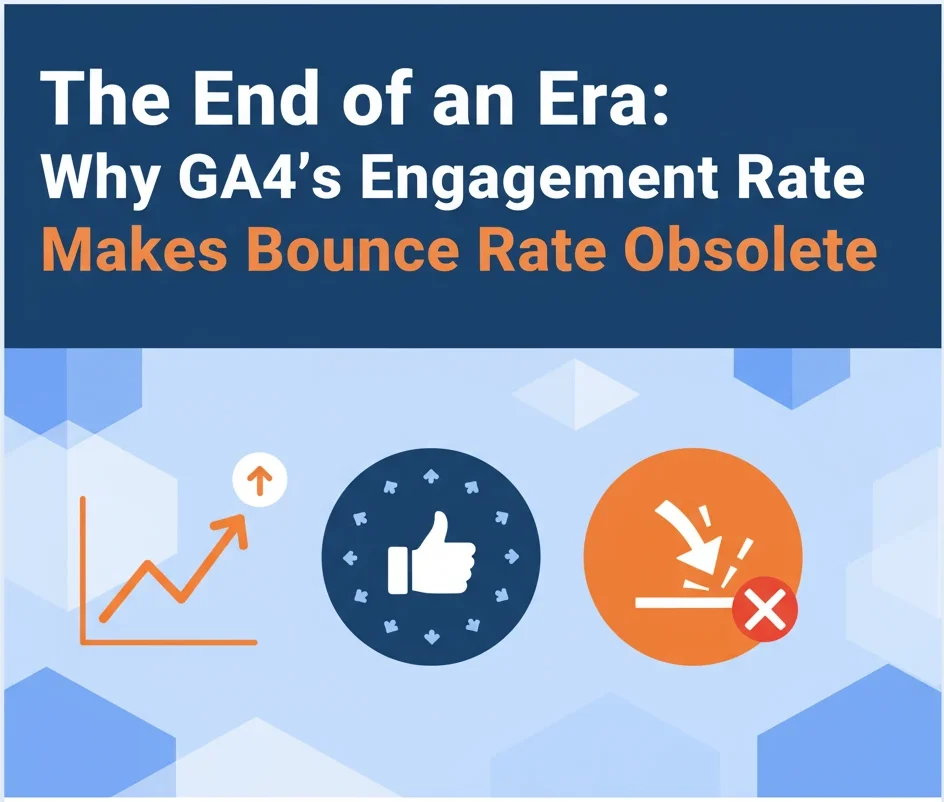For years, marketers and analysts were obsessed with a single, anxiety-inducing metric: bounce rate. A high bounce rate was seen as an undeniable sign of failure—users landing on a page and leaving without a second thought. Teams spent countless hours trying to lower it, often by optimizing for a meaningless second click.
With Google Analytics 4 (GA4), that era is officially over. Bounce rate has been replaced with a smarter, more actionable metric: Engagement Rate.
This isn’t just a rebrand—it’s a fundamental shift in how we measure user satisfaction and digital success. Here’s why engagement rate is a superior metric and why clinging to bounce rate can mislead your business.
What is GA4 Engagement Rate?
GA4 defines engagement rate as the percentage of engaged sessions on your website or app.
A session is considered engaged if a user does at least one of the following:
- Stays on the site/app longer than 10 seconds.
- Triggers a key event (what UA used to call a conversion or goal).
- Views two or more pages/screens.
The formula is simple:
Engagement Rate = Engaged Sessions ÷ Total Sessions
In GA4, bounce rate is now the inverse of engagement rate. If your engagement rate is 75%, your bounce rate is 25%. Instead of measuring “who left,” GA4 measures “who stayed.”
👉 Google’s official GA4 documentation explains this redefined metric in detail.
The Fundamental Flaw of the Old Bounce Rate
Universal Analytics defined a bounce as a single-page session with no interaction. That black-and-white rule often mislabeled perfectly successful visits as failures.
Consider these real-world examples:
- The Contact Page Visit: A user searches for your business, lands on your contact page, grabs your phone number, and calls you. That’s mission accomplished—but UA counted it as a bounce.
- The Blog Reader: Someone finds your 2,000-word article, reads it fully, gets the answer they need, and leaves satisfied. A successful interaction, but still a bounce.
- The Quick Conversion: A visitor lands on a promo page, copies a coupon code, and leaves to use it. Direct revenue impact—yet a bounce.
In all these cases, intent was fulfilled quickly and effectively, but bounce rate punished you for it. It measured a lack of clicks, not a lack of value.
Why Engagement Rate is Smarter
GA4’s engagement rate fixes these flaws by adopting a positive, user-centric measurement framework.
1. It Measures Positive Signals, Not Negative Ones
Instead of focusing on who “left,” GA4 highlights what users did. This shifts strategy from “How do we stop people from leaving?” to “How do we deliver real value?”
2. It Respects Single-Page Success
The 10-second rule acknowledges that consuming content counts as engagement. If someone reads your blog post for 3 minutes and leaves, GA4 records an engaged session. Finally, content-heavy sites get fair credit.
3. It Ties Directly to Business Goals
Key events (form fills, signups, purchases) are baked into the definition of engagement. That makes engagement rate a much better ROI proxy than bounce rate ever was.
4. It Provides a Clearer View of Traffic Quality
Now you can confidently analyze channels. A traffic source with a high engagement rate is driving truly interested visitors—even if they don’t always click deeper. This helps you allocate budgets wisely.
For more on GA4’s engagement tracking improvements, check out Analytics Mania’s guide on GA4 engagement.
How to Use Engagement Rate in Your Analysis
Ditching the bounce rate mindset opens the door to smarter analysis. Start by asking:
- Which pages have the lowest engagement rates? These are true problem areas—maybe slow load times, weak content, or misleading titles.
- Which traffic sources drive the highest engagement? Double down on those channels. If organic search brings engaged users, your SEO strategy is working.
- How does engagement correlate with conversions? Analyze the user paths of your most engaged visitors. What content do they consume before converting? Use these insights to improve internal linking and content flow.
Conclusion: Embrace the Change
The shift from bounce rate to engagement rate is one of GA4’s smartest upgrades. It moves us away from a flawed, negative metric and toward a positive, flexible, and more accurate measure of user value.
Stop chasing that meaningless second click. Instead, focus on creating content and experiences that engage users—whether that means reading, converting, or exploring further.
Your users—and your analytics—will thank you.
👉 Want to improve your GA4 setup or tracking strategy? Get in touch with us.
